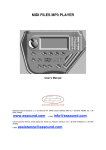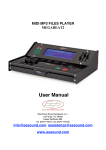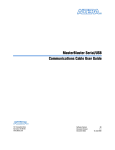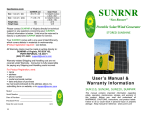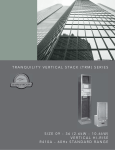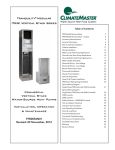Download Electronic Sound Solutions M-Blaster2 User`s manual
Transcript
MIDI FILES MP3 PLAYER User’s Manual: Electronic Sound Solutions s.r.l., via Monviso 54, 46042 Castel Goffredo MN, tel. + 39 0376 780360, fax + 39 0376 778225 www.essound.com e-Mail [email protected] Distributed in Australia by The Midi People: PO Box 270 Jannali NSW 2226 Ph: 02 9542 4105 Web: www.ausmidi.com Email: [email protected] 2 INDEX INTRODUCTION..........................................................................................3 CONNECTION AND COMMANDS..............................................................4 POWER SUPPLY .......................................................................................6 AUDIO CONNECTIONS..............................................................................6 HOW TO START .........................................................................................6 SWITCHING ON..........................................................................................7 SONGS .......................................................................................................8 HOW TO PLAY A SONG ............................................................................8 EASY TUNE.................................................................................................8 OPERATIONAL MODE................................................................................9 FUNCTION KEYS (FIG.1/6).........................................................................9 SONGS MODE .........................................................................................10 CHORDS AND LYRICS VISUALIZATION.................................................11 PLAY/STOP/CONTINUE ..........................................................................12 PARAM. (PARAMETERS).........................................................................13 TRKCHANG (TRACK CHANGE)...............................................................15 PARAMETERS FOR MIDI FILE ................................................................15 PARAMETERS FOR MP3 FILES............................................................. 18 PLAY LIST ................................................................................................19 HOW TO CHOOSE A LIST OF SONGS IN “PLAY LIST” MODE ….….....20 HOW TO PLAY SONGS IN PLAY LIST ................................................... 20 LIST Visualize the list of songs in a group.................................................21 TEXT and TRKCHANG..............................................................................22 MENU/INFO...............................................................................................22 SONGS ERASE.........................................................................................23 USB............................................................................................................24 TV SETUP..................................................................................................24 OPERATING SYSTEM..............................................................................25 TECHNICAL DATA SHEET.......................................................................26 WHAT TO DO IF: ......................................................................................27 3 INTRODUCTION First of all, ESS would like to thank you for your purchase of M-Blaster. M-Blaster is a MIDI, Karaoke and MP3 player characterised by a very intuitive user interface. M-Blaster plays: Standard MIDI files (.mid format 0 and 1) Karaoke files (.kar format 1) MP3 files (VBR/CBR, successfully tested up to 256 Kbps (depending on the encoder)) M-Blaster uses a Compact Flash Card as a data storage unit. The M-Blaster can be loaded with up to 511 songs. Included in the packaging are: Off- Line Switching Power Supply Adapter; CD-Rom containing the e-link software to transfer, manage and backup files; Operating manual; USB cable; Compact Flash card; Audio/Video cable (L+R Red/White / Video Yellow). 4 CONNECTION AND COMMANDS Frontal panel 1 9 10 2 3 4 11 5 6 12 7 8 Fig.1 1) Adjustment knob, to modify the values of the various parameters and change the displayed page; 2) Use this button to access the global adjustments on the player, like: global equalization, effects adjustment on the inputs Mic1/Mic2, global transposition on MIDI songs; 5 3) Use this button to access options like: song erasing, adjustment of the TV set if connected and transferring files from PC to Compact Flash Card. If this button is pressed while a song is in “play” mode, the screen will display info about the song. It is possible to adjust the display contrast by pressing this key and rotating the alpha dial knob. 4) These buttons are used for the “Easy Tune” feature, which enables instant adjustment of the tonality/key of the song for a Male or a Female performer. 5) Function buttons. These buttons select different functions, depending on the page displayed on the screen; 6) Compact Flash Card housing; 7) Play/Stop, to start or stop the song playback; 8) Arrow buttons, to select elements visualised on the screen. 9) Exit current screen, or go back to the previous screen; 10) High brightness backlit display; 11) Individual microphones volume fader; 12) Global volume fader. Back Panel 1 2 3 4 5 6 7 8 9 Fig.2 1) Stereo mini-jack output for headphones connection; 2) 2 Microphones inputs (Jack 6.3 mm TSR); 3) 2 Audio outputs (to be connected to the audio system); 4) Video connectors. Output (Video out) / Input (Video in) 5) Connector for optional external lyrics display or video camera power supply 6 6) Port MIDI Out to connect an external sonic generator; 7) USB connector to connect M-Blaster to a PC; 8) Switch on; 9) Connection to the supplied external power supply adapter; POWER SUPPLY Connect the adapter plug (male) to the PWR IN female connector positioned on the M-Blaster back panel (Fig.2/9). Then connect the adapter plug to a power point. IMPORTANT Please only use the adapter supplied, otherwise the equipment can be damaged. AUDIO CONNECTIONS Connect the M-Blaster Audio Outputs (fig 2/3) to your audio equipment (mixer line input or directly to the line inputs of audio equipment - AUX or TAPE - of your home Hi-Fi or similar). Note: In order not to damage the audio equipment it is strongly recommended that M-Blaster is not turned on before the amplification set-up. HOW TO START M-Blaster is supplied with “e-link” software for the Personal Computer which allows you to transfer MIDI and MP3 files directly from your PC to the MBlaster data storage unit (Compact Flash Card). This software can also be used for backup operations. First of all install the supplied software on your PC, then connect your M-Blaster through a standard USB cable A/B (such as the one used for USB printers) to a properly functioning USB port on the PC. 7 Note: when executing the program, if correctly set, M-Blaster will automatically position on the “USB” page. After having done this, launch the program by double clicking on the icon created during installation. As for the software utilization, please refer to the on-line guide included with the software. SWITCHING ON To switch the M-Blaster on, insert the supplied adapter connector into the corresponding socket positioned on the back panel and push the ON button. The display will light up and after a few seconds, you will see the following: READING PROGRAM Shortly followed by: ESS M-BLASTER VERSION XXXX MIDI Karaoke Mp3 Player For its correct functioning M-blaster needs the Data storage unit (Compact Flash Card), to be inserted in its proper housing (fig1/6). Otherwise, the following message will appear on the screen: “COMPACT FLASH NOT PRESENT” Note: The Compact Flash Cards are formatted when the product is sold; however, if necessary, the formatting should be executed with the following characteristics: FAT 12/16 bit formatting (it will be implemented to FAT 32). 8 Insert the Compact Flash in its proper housing (fig1/6) without forcing it. MBlaster will then display the songs page by page. It is possible to adjust the display contrast by pressing the MENU key (fig 1/3) and rotating the alpha dial knob (fig. 1/1). SONGS The page on the display contains the songs list, in MIDI or MP3 format, in alphabetical order, 6 titles of 26 letters per line. The audio songs (MP3) are marked by the “A” letter before the title while the MIDI files are preceded by the suffix “M” (.mid) or “K” (.kar). Above left of the display is the current page number. To visualize the other pages rotate the switch (fig. 1/1): at every click the page will change to a new one containing 6 songs. It is also possible to move one song at a time, utilizing the arrow buttons (fig. 1/8); after the last song the next page will be displayed. HOW TO PLAY A SONG It is extremely easy to play a song. Highlight the required song with the arrow buttons (fig. 1/8), and then push the PLAY button. To stop the playback, just push the STOP button. It is also possible to keep playing the song from where you stopped it by using the function buttons (fig. 1/5) to select CONTINUE as it appears on the display. EASY TUNE Thanks to this exclusive function it is possible to instantly adjust, before or while playing a MIDI song, the tonality key depending on the user needs. The functioning is extremely intuitive: MALE: if this key is lighted M-Blaster will adjust the MIDI song key for a male voice; 9 NORMAL: if this key is lighted M-Blaster will play the MIDI song in its original key; FEMALE: if this key is lighted M-Blaster will adjust the MIDI song key for a female voice. Note: the tonal transposition of “EASY TUNE” is not automatically saved. In order to do that, the transposition will have to be done (and then saved) in the “TRKCHANG” (track change) page. Despite the fact that “EASY TUNE” transposes most MIDI songs correctly depending on the performer (male/female), it is possible that certain songs, with special peculiarities, will not adapt perfectly to the transposition. You can find the tonal transposition of “EASY TUNE” on the PARAM-MIDI page. OPERATIONAL MODE The meaning of the words and the symbols visualized on the display varies depending on the chosen mode: In SONGS mode: name of the songs; In PLAYLIST mode: name of the groups; In MENU/INFO mode: player managing functions or played song characteristics; In PARAM. mode: MIDI/Audio global adjustments functions, like the MIDI transposition and equalizations. FUNCTION BUTTONS (fig.1/5) The use given to the four function buttons F1-F2-F3-F4 is variable and changes from time to time depending on the active operational mode. Clearly, it is not necessary to remember which function is assigned to every button as it shows on the last line of the display: there are four boxes at the bottom of the display which correspond to the four function buttons directly below them. 10 In this way the four function keys can always access the “typical” functions of the operational mode running in that moment. SONGS MODE The functions offered by the SONGS mode allow to: Choose with the arrow buttons a single song to play using the PLAY key; Visualize chords and lyrics (if memorized in the song); Adjust volume, effects, transposition and tempo of the song (“TRKCHANG”); Instantly exclude the melody track (if present in the MIDI file). Authorised function keys: When there are no songs playing in SONGS mode, M-Blaster is in “stand-by” (the STOP button is lighted while the PLAY button is off). In the last line of the display the following function keys are active: “TRCK ON” / “TRCK OFF”: this allows stopping the melody track from playing. The factory set MIDI channel is 4, however in “Param.” “MIDI” it is possible to assign the value to other channels as well. Once set, the parameter will remain active until the equipment is turned off or when the function is disabled; o “TRCK ON” the melody track (ch4 default) is activated; o “TRCK OFF” the melody track (ch4 default) is disabled; “PLAYLIST”: allows to access the PLAYLIST mode described later; “TEXT”: allows accessing the visualization mode of chords and lyrics. When the M-Blaster is in “PLAY” (Green led above the PLAY key is lighted), in the last line of the display the following function keys are active: “TRCK ON” / “TRCK.OFF” (see above); “LIST” (see above); “TEXT” (see above); “TRKCHANG (TRACK CHANGE)”: Adjust many variables such as the volume, reverberation, 11 chorus, transposition and tempo of the song being played. Note: The function TRKCHANG is only available when the song is in “PLAY” because the adjustment values of the single parameters vary depending on the starting value that’s preset on each song. To read the preset starting values of each song (normally included in the first measure of the song) it is necessary to put the song in PLAY. Pushing the STOP button twice, makes the effects (Rev./Delay/Chorus) come momentarily off from MIC1/2 (“TALK” mode). The effects will automatically reactivate when you start playing a song. When a song is interrupted by pressing the STOP button, the function TRKCHANG is replaced by: “CONTINUE”: This function is usually coupled with the functions Play/Stop, and it is used to restart a song exactly from the point where it had been interrupted by the STOP button. CHORDS AND LYRICS VISUALIZATION This function is activated by the “TEXT” function button, and can be used either before or after having put a song in PLAY. It is probably better to press text before you start the song so you can be ready for any lyrics at the beginning of the song. If the song contains lyrics or chords and lyrics, press TEXT and then PLAY. To leave the TEXT mode, push the EXIT button. NOTE: Lyrics and chords, if present in the midi file, are visualized slightly in advance with respect to the part of the song being played, to give the 12 performer the time to get ready. The amount of time the lyrics come up in advance depends on the setup of the midi file. It is possible to enter the TEXT mode even after having the song in PLAY. It is also possible to enter and exit the TEXT mode at any time during the song performance. If you enter the TEXT mode while the song is being played, it will sometimes be a short wait before being able to visualize the correct lyrics on the display. It may also “lose” the lyric portion that should be visualized while activating the TEXT mode. Don’t worry – the M-Blaster will catch up to itself. For the chords and lyrics to be seen on the display, they have got to be memorised in the MIDI file. The readable formats are: Tune 1000 (files with extension “.mid”): in format “1” or “0” Solton (files with extension “.mid”): in format “1” or “0” Word Box/M-Live (files with extension “.mid”): in format “1” or “0” Karaoke (files with extension “.kar”): in format “1” PLAY/STOP/CONTINUE In SONGS mode, to PLAY a song, select it with the arrow buttons. Pushing the PLAY button will play the highlighted song. Pushing the MENU/INFO button while the song is playing will display: The full title of the song playing; For MIDI files, the time signature (4/4, 3/4 etc); For MIDI files the current position, indicated in measures and in quarters of measures, for Mp3 files the time gone from the start of the track; For MIDI files the metronomic time, for MP3 files the bit rate value (kbps). If the STOP button is pushed during the song playback, the song will be paused. At this point it is possible to use the CONTINUE function key to continue 13 (to restart the song playback from the point where it was paused). You can also push the PLAY button again to restart the song from the beginning. NOTE: The song that is playing is always the one highlighted with the arrow buttons. If one song is playing then another one is highlighted pushing the PLAY button will stop the first song and the new song will start immediately. If a song is interrupted with the STOP button read the following: After halting a song with the STOP button and highlighting another one, using the PLAY button will start the song from the beginning. Using the CONTINUE function will resume the first song playing (from the point where it was halted). PARAM. (Parameters) Press the PARAM. button while a song is playing to access the “Parameters” page where it is possible to adjust the MIDI and Audio parameters in real time (during playback). All parameters can be changed using the adjustment knob (fig. 1/1). The function keys in PARAM permit the selection of the following pages: 1. MIDI, which enables adjustment to the following: MIDI TRANSPOSE: This adjusts the global transposition (of all the MIDI files). The value can be varied by 12 semitones before or during the song playback. This parameter will be active until the equipment is turned off. MIDI REVERB: This adjusts the global quantity of the reverberation effect on MIDI tracks. MUTE TRACK: This enables you to choose which track is the melody track (in case you would like it muted with the TRKON/OFF function. The TRKON/OFF factory preset value is 4 as the melody track is usually assigned to this MIDI channel. EASY TUNE: Shows the ‘easy tune’ value (+4 semitones for male, 0 for normal or -4 for female). 2. “OUT EQ”: This adjusts the output global equalization. 14 The adjustable parameters are: TREBLE : high frequencies; BASS: low frequencies. 3. “MIC EQ”: This adjusts the equalization of the microphone inputs Mic1 and Mic2. The adjustable parameters are: HIGH: high frequencies; MID F: MID intervention frequency; MID: medium frequencies; LOW: low frequencies. NOTE: The equaliser on the medium frequencies is of the “semi-parametric” type. The “MID F” parameter enables adjustment to a particular frequency, enhancing or easing it up through the “MID” parameter. This means that intervening exclusively on the “MID F” parameter will make no tonal variation. The intervention frequencies start from 110hz (identified as low frequencies) and go up to 1800hz (identified as high frequencies, or high pitched) and cover the range of frequencies not modifiable by the “HIGH or “LOW” regulations. A practical example to understand the regulation of the semiparametric filter: enhance the “MID” parameter, then, speaking in the corresponding microphone move as you please the parameter “MID F”. It will be then possible to hear the different frequencies to enhance (or ease up) using the “MID”. 4. “MIC FX”. This adjusts the type and quantity of the effect for the Mic1 and Mic2. The adjustable parameters are: DELAY TYPE: To choose among three types of delay: Mono/Stereo/Triple; DELAY LEVEL: To change the quantity of delay effect; REVERB SEND: To change the quantity of reverberation; CHORUS SEND: To change the quantity of chorus effect. “EXIT”: To leave the “PARAM.” page. 15 TRKCHANG (TRACK CHANGE) This function allows adjustment to the customized parameters of each song (volumes/effects /transposition/time etc). During playback it is possible to adjust and save customizations for each single song by pressing the TRKCHANG function key (can only be activated while the song is playing) The TRKCHANG page is different depending on the type of file played, MIDI or audio (MP3). NOTE: The effect generator (reverberation and chorus) is common between the MIDI playback and the MIC1/2, so the reverberation and/or chorus characteristics can be changed depending on the type of messages coming from the MIDI file in playback. PARAMETERS FOR MIDI FILES To adjust the volume, effects, transposition, tempo and other parameters of a MIDI file, select the TRKCHANG function. As explained above, this function is accessible from the main SONGS page and only available after the song has started. Once TRKCHANG is activated, this is what the function keys do: RESTORE: This zeroes all the variations to their parameters and restores the presets originally memorized in each song; 16 SAVE: Saves the modifications made by the user. RELOAD: Recalls the last values saved by the user. MUTE: Mutes a track (same as zeroing the volume MIDI channel). This function is only available if ‘VOL’ in the TRKCHANG window is highlighted. SOLO: “Solos” the highlighted channel. This function is only available if ‘VOL’ in the TRKCHANG window is NOT highlighted. NOTE: None of the variations done through the TRKCHANG function will modify the original parameters of a song. To understand how TRKCHANG works, imagine a chart attached to the song, in which all the variations on the default song values done by the user are memorised (+/- values). For instance a song with the volume on the MIDI channel n°2 might be recorded with the following progression: first measure (beat 1.1) set to Volume=100 tenth measure (beat 10.1) set to Volume=110 When the song is in PLAY, the M-Blaster will display (in correspondence to the MIDI channel n°2 volume) the value “100” until the tenth measure. After that we will read “110”. Let’s imagine we set a variation on the channel 2 volume using the PAGE/VALUE knob equal to “-020” (saving the variation with the SAVE function key). Playing the song again will display (in correspondence to the MIDI channel n°2 volume) the value “080” until the tenth measure and “90” after that. This means that with the TRKCHANG function it is possible to set variations that will add up (or subtract) the preset parameter values of songs. Such variations can be saved on the Compact Flash (in a chart attached to the song) and will have effect only when the song is being played and will not affect the original parameters which can be recalled any time. Once TRKCHANG is activated, the display shows a page divided in two zones by a status bar. The upper part concerns the managing of the single MIDI channels, while the lower one allows choosing from which parameter to work. 17 Variations can be made on the following parameters: VOL (Volume) TRN (Transpose) PRG (Program change) BNK (Bank select) REV (Reverberation) CHR (Chorus) PAN (Panpot) TEMPO (metronomic time) Use the arrow buttons to highlight a parameter of the lower part to work on. You can also globally modify all the MIDI channels using the adjustment knob (fig. 1/1). In that case the modifications shown on the status bar will be those of GLOBAL followed by the name of the parameter in use and from the word TRKCHANG. It is impossible to make global changes to PROGRAM CHANGE or BANK SELECT. Using the arrow buttons to move to the upper part (the status bar will read the word “CHANNEL” followed by the name of the variation in use and by the word TRKCHANG) you can adjust the parameter in use of the particular midi channel on which the arrow buttons are highlighting. The upper bar reports the name of the instrument assigned to the MIDI channel where the arrow buttons are positioned and the value of the parameter in use, visualized as a variation (-/+) set by the user for that channel. NOTE: on channel 10 transposing is only possible in “CHANNEL” mode The usable function keys in the TRACK CHANGE page have the same function as in the previous operative systems: RESTORE, SAVE, RELOAD and MUTE with the addiction of a new one that changes its use depending on the parameter it is working with. More precisely: “MUTE”: This is only visualized when working on the volume parameter. Pushing this function key changes the track on which the arrow buttons are positioned. 18 “SOLO”: Visualized for all the other parameters. Pushing this function key will play only the channel on which the arrow buttons are positioned in that moment. PARAMETERS FOR MP3 FILES To make adjustments to an audio file (MP3) select the TRKCHANG function. As described above, this function is accessible from the main SONGS page by using the corresponding function key. TRKCHANG is only an option after the song has started: Once TRKCHANG is selected the function keys have the following uses assigned: RESTORE: “Zeroes” all the variations done to the parameters by the user and restores the presets originally memorized in each song; SAVE: Saves the modifications made by the user. RELOAD: Recalls the last values saved by the user. MUTE: This parameter is not usable on this page. The parameters available in this page are: LEVEL: Adjusts the volume of the song in playback, 19 TREBLE: Increases or decreases the level of the high frequencies (treble), BASS: Increases or decreases the level of the low frequencies (bass), PANPOT: Adjusts the balance between the two stereo channels (left/right), PITCH: Modifies the key of the song playing without altering its tempo. The values allowed are +/- 6 semitones, TIME STRETCH: Modifies the tempo of the song in playback without altering its key (pitch). The values allowed are +/- 3. NOTE: The “PITCH” and “TIME STRETCH” functions can be very useful, however is important to remember that the sound quality will decrease the more the original mp3 is modified. PLAY LIST The PLAY LIST is what M-Blaster uses to organize the files in a simple and intuitive manner. You can create a PLAY LIST containing songs to be played sequentially (to help organize repertoire) or to group song by genre using the ELINK software. Also, any song is able to be part of more than one Play List (without duplicating the song on the Compact Flash). This means you can choose the same song from alternative play lists. Each Play List can contain a maximum of 48 songs, mixed between MIDI files and/or MP3. M-Blaster has a capacity of up to 100 groups. The functions offered by the play list mode allow to: Choose a group of songs to play (using the PLAY button). Choose whether to play the songs in sequence (one after the other) or to select and then play songs from the PLAY LIST in any order one at a time, Visualize chords and lyrics (if memorized into a song), Customize parameters like volumes, effects, transposition and tempo of the song playback. To activate the PLAY LIST mode, start from the SONGS mode and then push the PLAY LIST function key. 20 Function Keys activated: If you are in PLAY LIST mode and there are no songs PLAY LIST (or if the previous song is finished) M-Blaster is in “Stand-by” (STOP button is lighted – PLAY button is not); in the last line of the display the following function keys are active: LOOP/NOLOOP: To decide whether songs start to play immediately after the previous song is finished (LOOP) or if the M-Blaster should wait for you to press PLAY before it plays the next song (NOLOOP) ; LIST: To show the list of songs that are part of that play list and to choose which song of the list to play, TEXT: Shows any text (generally lyrics or chords) that are part of the highlighted file. When the M-Blaster is in “PLAY” (green ‘PLAY’ button is lighted) there are more function keys active: TRKCHANG: Adjusts many variables such as the volume, reverberation, chorus, transposition and tempo of the song being played. When the song playback is halted through the STOP button, the TRKCHANG function key is substituted by CONTINUE. CONTINUE: This is used to restart a song exactly from the point where it had been interrupted by the STOP button. HOW TO CHOOSE A LIST OF SONGS IN PLAY LIST MODE Once the PLAY LIST mode is accessed, you can see the group of songs created on the display (they can be setup only through the management software supplied with M-Blaster) To choose a PLAY LIST highlight it with the arrow buttons (fig. 1/8) or move to another page with the alpha dialer (fig. 1/1). HOW TO PLAY SONGS IN PLAY LIST Before playing the songs contained in a PLAY LIST, decide whether the songs should be played sequentially (one after another), or if the songs will be played in a different order to how they are listed in the play list (meaning each song 21 will be selected manually after the previous song is finished). This selection is made using the LOOP/NOLOOP function key. The current selection (LOOP/NO LOOP) is visible on the lower left part of the display. Pushing the corresponding function key will change from LOOP to NOLOOP and vice versa. NOTE: The switchover between the two modes LOOP/NOLOOP can be activated while a song is playing. If you push the PLAY button upon first opening the play list, the first song from the group will start. Just like in the SONGS mode, pushing the MENU/INFO button during the song playback, you can view these song characteristics: The name of the selected song; The time signature (4/4 – 3/4 etc); The current position, in beats and quarters (for instance 059.4); The metronomic time. Just like in SONGS mode, when a song of a PLAY LIST is in playing, the TEXT and TRKCHANG function keys are active; once the playback is halted with the STOP button, TRKCHANG switches to CONTINUE. To see the songs of a PLAY LIST, push the LIST function key. As usual, use the alpha dial switch to go the next page for a maximum of 8 pages (each of 6 songs for a total of 48 per list). You can move among the songs that are part of the group using the arrow buttons. After having highlighted a song with the arrow buttons, pushing the PLAY button will start that song. When the LOOP mode is active all the songs will play in order automatically until the last one of the group. To go back one page just push the EXIT button. From there you can choose another play list if you would like. 22 TEXT and TRKCHANG In PLAY LIST mode the TEXT and TRKCHANG functions are similar to their functions in SONGS mode. If a playlist is in LOOP mode and the TEXT or TRKCHANG function is active, the data about the song currently playing will always be showing. (For example, if the current song finishes and the next one starts, the data showing in the TEXT or TRKCHANG display will also change to the new song). The TEXT and TRKCHANG functions can be displayed by pressing their corresponding function keys, available either on the main PLAY LIST page or in the LIST pages. MENU/INFO The MENU/INFO page contains various and important management utilities for the M-Blaster. To access the MENU page, push the MENU/INFO button when the M-Blaster is in “Stand-by”, (not playing – PLAY button led is off). It is otherwise impossible to access the MENU page. The functions contained in the MENU section are: SONGS ERASE: to erase a song from the Data Storage Unit (Compact Flash); USB: Go to this page to transfer MIDI and/or MP3 files from the computer (using the supplied software) to the Data Storage Unit (CompactFlash); TV SETUP: To access the TV visualization options menu; CLEAR ALL DATA: To delete every file from the Compact Flash. Also, in the lower right part of the page it is possible to find info related to the single device: S.N. : Device serial number; Sysop : Operative system version installed on the device; Eprom : Version of resident software; Songs: The number of songs in the Compact Flash. 23 The activated function keys are: INTRO ON / OFF: Allows the user to activate / deactivate the short musical intro when the unit is turned on. SELECT: Allows access to one of the functions previously described (the selected one). Once the MENU page is showing, to access one of the functions previously described, highlight the desired function (using the arrow buttons) and then select it with the SELECT function key. SONGS ERASE This function allows the permanent deleting of a song. To activate it: 1. Push the MENU/INFO button; 2. Highlight SONGS ERASE with the arrow keys; 3. Push the SELECT function key. All the songs present in the Flash Card will display (divided into pages and accessible by using the arrow buttons (fig. 1/8) and the alpha dial switch (fig. 1/1) The function keys activated are: ERASE: delete procedure 1. Choose the song to delete with the arrow buttons (fig 1/8) (or with the alpha dial knob) (fig. 1/1) then push the ERASE function key; 2. If you wish to leave the ERASE mode without deleting any files, push the EXIT button. To delete the song push the YES function key when requested, otherwise push NO. You can then either delete another song or push the “EXIT” button to return to the MENU page. 24 USB This page should be shown when the M-Blaster is connected to the PC. If you modify the content of the Compact Flash, the “INDEX” is automatically shown when you exit from the USB page. TV SETUP In this section it is possible to adjust the functions related to the device connected through the video connector positioned on the back panel (fig 2/4). To activate the TV SETUP function: 1. Push the MENU button; 2. Use the arrow buttons to highlight TV SETUP; 3. Push the function key SELECT. The activated function keys are: SAVE: This memorizes the changes made in this page; CHANGE: This allows the variation of the selected parameter. The parameters that are able to change are: LIST SONGS ON TV: This allows (or prevents) the list of songs on the connected TV screen to be shown. If ENABLED is selected, the song titles will be shown on the external screen at the end of the song, just like on the M-Blaster display (6 songs). If switched to DISABLED the list will not be shown on the external screen. NOTE: Changes to this parameter do not affect the MBlaster’s internal display. CHORDS ON TV: Allows (or prevents) the visualization of the chords, if present in the MIDI file, on the connected TV screen. BACKGROUND COLOR: Allows the adjustment of the background colour in the chords/lyrics page (if present in the MIDI file). CURSOR COLOUR: Allows the adjustment of the highlighted colour; 25 VIDEO/CAMERA IN: If the optional Video camera is connected, use this parameter to adjust signal of the video camera in the background of the TV. CLEAR ALL DATA: This function is used to delete all contents of the Compact Flash. To clear Compact Flash, “YES” has to be pushed, and then pushed again in order to confirm deleting the songs. At the end of deleting, this message shows: “SWITCH POWER OFF – THEN ON AGAIN”. OPERATING SYSTEM The M-Blaster Operating System comprehends all the commands and functions that allow all the operations described in this manual to happen. The Operating System is preloaded by ESS and automatically loaded by the device when switched on. Just like a computer it is possible to update the M-Blaster Operating System to add new functions and/or to better the already existing ones. The update procedure is very easy. Please refer to the on-line guide of the supplied data transferring software. PLEASE NOTE CAREFULLY Once the transfer of the SysOp is over, switch the M-blaster off only when the following message appears on display: SWITCH POWER OFF THEN ON AGAIN 26 It requests that the M-Blaster is switched off and then on again. After switching on, the operating system will be installed and the version number can be verified on the opening screenshot. TECHNICAL DATA SHEET • ADAPTER: External off-line power supply adapter desktop switching Off Line In .......90/240 Vac Out ....15 v. 2A • CONNECTORS: Inputs Mic balanced (Jack 6,3mmTSR) Stereo output (n.2 pin RCA L+R) Video connector OUT (Pin RCA) cinch Video connector IN (Pin RCA) USB Port Earphones output (mini-jack 3,5mm TSR) MIDI OUT port (din 5p. standard) • BACKLIT GRAPHIC DISPLAY: 192 x 64 dot size 0,4x0,4 mm / dot pitch 0,45x0,45 mm • DIMENSIONS 250 x 170 x 60 mm • WEIGHT M-Blaster 1.4 Kg Power supply adapter + Cable 0.45 Kg 27 WHAT TO DO IF If the message “compact flash not formatted” appears while the card is in, format the Card on your PC with file system “fat” in slow Mode. If the message “fat type not supported” appears while the card is in, please format the card on your PC with file system “fat” in slow mode. Important: Not every compact flash is compatible with M-blaster. If m-blaster stops with the message “init compact Flash” during initialising of the card, switch it off and turn it on again, pushing simultaneously the buttons “param” and right Pointer. By this procedure the initializing of the Songs is stopped and you can cancel the file using the e-link Software.



























